补差英语形容词和副词的用法和练习题1
- 格式:doc
- 大小:80.50 KB
- 文档页数:9
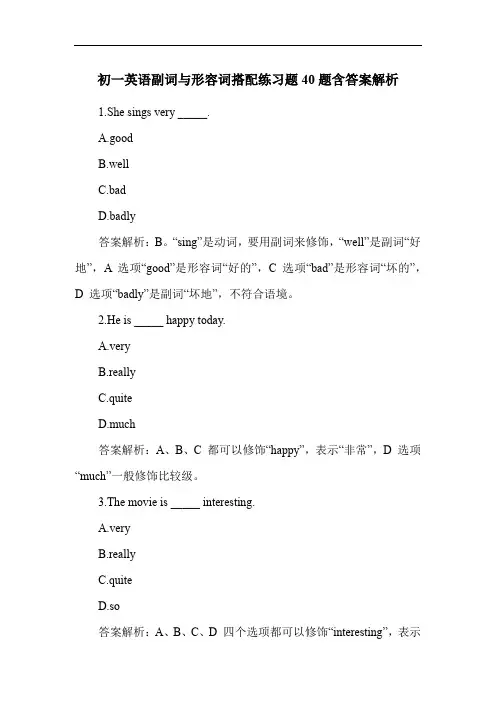
初一英语副词与形容词搭配练习题40题含答案解析1.She sings very _____.A.goodB.wellC.badD.badly答案解析:B。
“sing”是动词,要用副词来修饰,“well”是副词“好地”,A 选项“good”是形容词“好的”,C 选项“bad”是形容词“坏的”,D 选项“badly”是副词“坏地”,不符合语境。
2.He is _____ happy today.A.veryB.reallyC.quiteD.much答案解析:A、B、C 都可以修饰“happy”,表示“非常”,D 选项“much”一般修饰比较级。
3.The movie is _____ interesting.A.veryB.reallyC.quiteD.so答案解析:A、B、C、D 四个选项都可以修饰“interesting”,表示“非常”。
4.She is _____ sad.A.veryB.reallyC.quiteD.extremely答案解析:A、B、C、D 四个选项都可以修饰“sad”,表示“非常”。
5.The boy is _____ naughty.A.veryB.reallyC.quiteD.extremely答案解析:A、B、C、D 四个选项都可以修饰“naughty”,表示“非常”。
6.The food tastes _____ good.A.veryB.reallyC.quiteD.so答案解析:A、B、C、D 四个选项都可以修饰“good”,表示“非常”。
7.She is _____ careful.B.reallyC.quiteD.extremely答案解析:A、B、C、D 四个选项都可以修饰“careful”,表示“非常”。
8.The weather is _____ bad.A.veryB.reallyC.quiteD.extremely答案解析:A、B、C、D 四个选项都可以修饰“bad”,表示“非常”。

英语语法专题(词法)形容词和副词1. 形容词在句中主要用作定语, 表语, 复合宾语的补语, 特殊结构中的状语:【例句】Miss Smith is a very good teacher.(前置定语)He has nothing pleasant to tell you. Something terrible will happen.(后置定语)Don’t feel sad, everything will be all right.(表语)They found the book quite instructive.(补语)They spent six days on the small island, cold and hungry.(状语)2.形容词的某些特殊用法1)当某些表示行为的动词用作系动词时, 作表语有些行为动词常用作系动词,后面应跟形容词作表语,不能误用副词。
常见这类动词有:appear,act,become,feel,fall,get,grow,look,remain, seem,sound,smell,stay,taste,turn,etc.【例句】We believe that he already feels very sad about his mistake and we have decided to take no further action.Since one of their members was a prisoner of war in Vietnam, the family felt bad when they heard over their radio that the peace were to be discontinued.2)表示人品的形容词的常用结构“It is十表示人品的形容词十of十代词十不定式”,这种结构用来表示对某人所做的事的一种赞赏,或者厌恶。
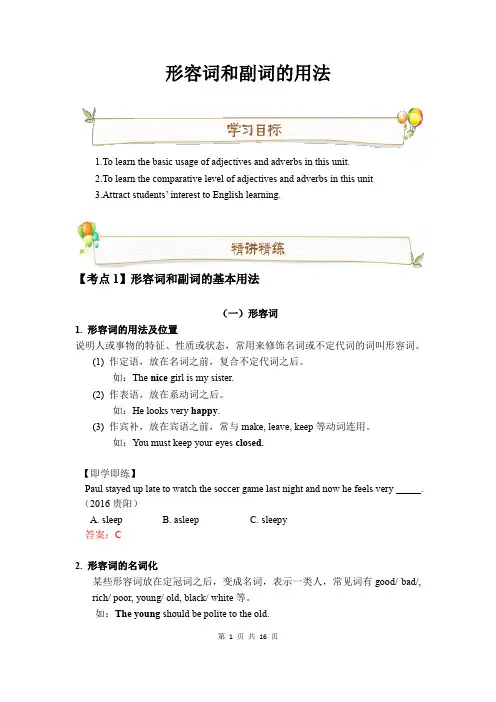
形容词和副词的用法1.To learn the basic usage of adjectives and adverbs in this unit.2.To learn the comparative level of adjectives and adverbs in this unit3.Attract students’ interest to English learning.【考点1】形容词和副词的基本用法(一)形容词1. 形容词的用法及位置说明人或事物的特征、性质或状态,常用来修饰名词或不定代词的词叫形容词。
(1) 作定语,放在名词之前,复合不定代词之后。
如:The nice girl is my sister.(2) 作表语,放在系动词之后。
如:He looks very happy.(3) 作宾补,放在宾语之前,常与make, leave, keep等动词连用。
如:You must keep your eyes closed.【即学即练】Paul stayed up late to watch the soccer game last night and now he feels very _____.(2016贵阳)A. sleepB. asleepC. sleepy答案:C2. 形容词的名词化某些形容词放在定冠词之后,变成名词,表示一类人,常见词有good/ bad/, rich/ poor, young/ old, black/ white等。
如:The young should be polite to the old.3. 形容词的顺序当名词由两个以上的形容词(包括一些具有形容词功能的限定词)修饰时,这些词的顺序通常遵循一定的规则,一般不得随意调换,也不能依照汉语的意思去排列。
通常可按下面的次序排列:(1) 限定词,包括:冠词、指示代词、形容词性物主代词、名词所有格、数词等。
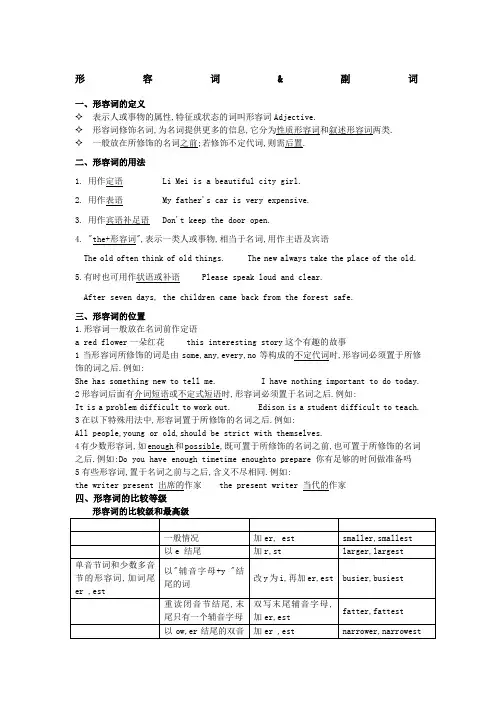
形容词&副词一、形容词的定义✧表示人或事物的属性,特征或状态的词叫形容词Adjective.✧形容词修饰名词,为名词提供更多的信息,它分为性质形容词和叙述形容词两类.✧一般放在所修饰的名词之前;若修饰不定代词,则需后置.二、形容词的用法1. 用作定语 Li Mei is a beautiful city girl.2. 用作表语 My father's car is very expensive.3. 用作宾语补足语 Don't keep the door open.4. "the+形容词",表示一类人或事物,相当于名词,用作主语及宾语The old often think of old things. The new always take the place of the old.5.有时也可用作状语或补语 Please speak loud and clear.After seven days, the children came back from the forest safe.三、形容词的位置1.形容词一般放在名词前作定语a red flower一朵红花 this interesting story这个有趣的故事1当形容词所修饰的词是由some,any,every,no等构成的不定代词时,形容词必须置于所修饰的词之后.例如:She has something new to tell me. I have nothing important to do today. 2形容词后面有介词短语或不定式短语时,形容词必须置于名词之后.例如:It is a problem difficult to work out. Edison is a student difficult to teach. 3在以下特殊用法中,形容词置于所修饰的名词之后.例如:All people,young or old,should be strict with themselves.4有少数形容词,如enough和possible,既可置于所修饰的名词之前,也可置于所修饰的名词之后.例如:Do you have enough timetime enoughto prepare 你有足够的时间做准备吗5有些形容词,置于名词之前与之后,含义不尽相同.例如:the writer present 出席的作家 the present writer 当代的作家四、形容词的比较等级副词的比较级和最高级1.大多数以ly结尾的副词前加more 和most 来构成比较级和最高级;2.少数单音节副词,加er,est 构成其比较级和最高级 ;3. 几个特殊的形容词和副词1 句型"as…as",表示两者相比较,程度相同.The old man walks as fast as a young man.2 句型"not asso…as",表示两者相比较,前者不如后者.I'm not as tall as Jack. 我没有杰克高.3 表示两者之间比较时,用"形容词比较级+than"或"less…than"两种句型.Your mother looks healthier than before.4 more and more… 越来越…….The park is getting more and more beautiful.5 the 比较级…the比较级… 越……就越…….The more books we read, the cleverer we will become.6 "the+比较级+of the two…"两个中较……的一个.I'd like to go to the farther of the two places.7 "比较级+than any other+单数名词"比其他任何……都…….Li Lei is taller than any other boy in his class.8 三者或三者以上相比较,用"the+最高级+名词+范围"结构.This is the cleanest place of the city.9 表示"最……之一",用"one of the+形容词最高级+复数名词".The Great Wall of China is one of the greatest buildings in the world.注意: 形容词最高级前面必须加定冠词the,但当形容词最高级前面有物主代词修饰时,则不加the.例如:正This is my best friend.误 This is my thethe my best friend.五、几种常见的形容词句型1.形容词+介词+名词或代词或动名词I'm not interested in playing computer games.My parents are pleased with my studies.2.It iswas+形容词+of/for+名词或代词+不定式It's foolish of me to make such a mistake.It was kind of the driver to send the old man home.3.形容词+不定式常用于这种句型的形容词有:able,sure,lucky,ready,happy,likely等. She is sure to pass the exam. I'm lucky to meet you here.副词的用法1. 副词修饰动词,在句子中作方式状语;例如:The man runs fast. fast修饰runs这个动作2. 副词修饰形容词,并且通常放在形容词的前面例如:He becomes very handsome.3. 在“副词+形容词”这样的结构中,中心词是形容词,副词只是为了说明程度大小即:very handsome的中心词是handsome4. 副词前面也可以加副词,例如上面的句子都可以改写成:The man runs very fast.very本身是副词,意思是“非常,很”,所以后面也可以跟副词或者形容词;❖填形容词还是副词实义动词后面跟副词,连系动词后面跟形容词;例如:She sings beautifully. sing是实义动词,beautiful用来说明唱得如何She looks sad. look是连系动词,后面跟形容词还有一些不是连系动词的词,例如make和get,要根据句子的意思判断填形容词还是副词;区分:He is making a kite carefully.carefully用来修饰make这个动词He made the teacher angry.angry是指the teacher,而不是修饰make这个动词于是有词组:make sb+adj. leave sb+adj. get+adj❖形容词和副词分别长什么样子1.形容词的词尾通常有ing/ful/ed/yinteresting、tiring、boring、exciting、surprising、amazing与物有关interested、tired、bored、excited、surprised、amazed与人有关careful、hopeful、wonderful、helpful、colorful、meaningful、beautiful rainy、windy、cloudy、dry、messy、easy、funny、busy、angry区分:The children were excited when they heard the exciting news.The man was tired劳累的 after doing so many tiring累人的 jobs.但是在interesting与interested中,形容人或物的都用interesting,而interested 常以词组be interested in的形式出现,表示“对…感兴趣”;The story is interesting./The teacher is interesting.2.副词的词尾通常是ly,但亦有一些不以ly结尾的副词;badly、surprisingly、carefully、hopefully、quickly、greatly、possibly通常是由形容词加ly变来hard努力地、well好、high高、fast快地、pretty十分,非常、very much/a lot 非常a little一点3.有些词既是形容词也是副词hard adj.硬的 adv.努力地 early adj.早的 adv.早地 late adj.迟的adv.迟high adj.&adv. 高 well adj.健康地 adv.好形容词比较级练习题一写出下列形容词与副词的比较级与最高级形式:long wide fatheavy slow fewbrightly badly farquickly happy unhappy 二用所给词的正确形式填空:1. Of the two girls, I find Lucy the clever.2. Gold黄金 is little useful than iron铁.3. My sister is two years old than I.4. John’s parents have four daughters, and she is the young child.5. The cheap bags are the not usually the best ones.6. The short one is by far expensive of the five.7. The boy is not so interesting as his brother.8. Dick sings well, she sings well than John, but Mary singswell in her class.9. She will be much happy in her mew house.10. This dress is than that one.expensive三翻译句子:1.这本书跟那本书一样有趣;This book is _____ _____ that one.2.你游泳没有你弟弟好;You can’t swim _____ _____ your brother.3.今天比昨天冷的多;It is today ______ it was yesterday. 4.这个故事比另一个有趣得多;This story is _____ ______ than that one. 5.他比我大两岁;He is _____ ______ than I.6.这个故事不如那个有趣;This story is _____ _____ than that one. 7.她的身体状况一天天好起来;She is getting ______ every day.8.他对英语越来越感兴趣;He is becoming ______ _____ _______ _____ English.9.他吃的越多,人越胖;The more he eats, the _______ he gets.10.你的问题是两个中比较难的那个;Your question is _______ ______ of two.副词练习一、将形容词变为副词1.easy2.hard3.true4.heavy5.careful6.happy7.fast 8.lucky 9.gentle10.possible 11.angry 12.sad13.good 14.bad 15.near16.terrible17.quick 18.nice二、用单词适当形式填空1. Look at the children on the playground. They are flying kites ________happy.2. Why do you think you did so ___________badin your test3. We can __________easy forgive a child who is afraid of the dark, but we can’t forgive an adult who is afraid of the light.4. Congratulations You’ve answered all the questions _________correct.5. The computer is wideused in our daily life. We can do many things with it.6. I changed into my sports shoes so that I could walk more ____________comfortable.7. Mary passed her examination because she studied very ________hard.8. “Why didn’t you tell me earlier ” The boss shouted _______hungry.9. It’s true possible that robot teachers will be popular in schools some day.10. How _________comfortable the giant pandas are living in Taiwan11. Miss Xu smiled and said to me ________soft, “Never mind, my boy”12. Last night it rained __________heavy in the southern part of the city.13. Simon hates to be like others, he often tires to do everything different.14. The children clapped their hands _________excited as soon as the astronauts appearedon the stage.15. Tom had an accident yesterday. His teacher sent him to the hospital quick.形容词与副词专项训练练习题1. Work gets done ________ when people do it together, and the rewards are higher too.A. easilyB. very easyC. more easilyD. easier2. My parents have always made me ________ about myself, even when I was twelve.A. feeling wellB. feeling goodC. feel wellD. feel good3. He began to take political science ________ only when he left school.A. strictlyB. trulyC. carefullyD. seriously4. The final score of the basketball match was 93-94. We were only ________ beaten.A. nearlyB. slightlyC. narrowlyD. lightly5. The new group of students is better-behaved than the other group who stayed here ________.A. earlyB. earlierC. earliestD. the earliest6. —Do you need any help, Lucy —Yes, The job is ________ I could do myself.A. less thanB. more thanC. no more thanD. not more than7. There is an old proverb, ―Love me, love my dog. But there is ________ wisdomin this: ―Love me, love my book.A. someB. muchC. moreD. most8. With April 18’s railway speedup, highway and air transport will have to compete with ________ service for passengers.A. goodB. betterC. bestD. the best9. The melon the Smiths served at dinner would have tasted ________ if it had been put in the fridge for a little while.A. goodB. betterC. bestD. well10. After two years’ research, we now have a ________ better understanding of the disease.A. veryB. farC. fairlyD. quite11. Speaking of all the songs he has written, I think this is probably his ________ one.A. better-knownB. well-knownC. best-knownD. most-known12. Of the two coats, I’d choose the ________ one to spare some money for a book.A. cheapestB. cheaperC. more expensiveD. most expensive13. —I wonder why Mary is so unfriendly to us.—She is ________ than unfriendly, I’m afraid.A. shyerB. much shyerC. shy moreD. more shy14. —I didn’t do well in this English examination. How about you—I did ________ you.A. not better thanB. no worse thanC. as well asD. no better than15. —Now that you like the house with a garden, why not buy it—Well, I can’t afford ________ house at present.A. that expensive aB. a such expensiveC. that an expensiveD. a so expensive用所给词的适当形式填空1.The river was so polluted that it _________actual caught fire and burned.2.Bend your knees slightly and reach out your arms like tree branches, naturally and _______ soft.3.Just be ______________ patience.4.Although parents should take _________ well care of their young children, they don’t ______________ necessary do anything for them.5.---Do you like Mary’s new hairstyle---Perfect How much ________ good she looks with the curly short hair6.--- Are you satisfied with the result of the exam--- Not at all. I can’t have a ________ bad one.7.--- Lily did succeed at last--- Yeah, indeed, but she was _______________ luck than successful, I think.8.That would be a very _________ reason thing to do in a big city, but it could destroy a small village like this.9.Mary felt __________ please, because there were many empty seats in the room.10. The teachers are very enthusiastic and __________ friend and the classrooms are _____________ amaze.单句改错只有一处错误1.The fruits are small in size, but juicy and taste.2.We don’t need to do so many homework. Therefore, we have more time for after-school activities.3.The teachers here are kind and helpfully. They are not only our teachers but also our friends.4. That is too much for us, considering how closely the houses are.5.I’m always caution about what I say because some careless remarks are likely to hurt other’s feelings.6.Doing physical exercise is an effect way to get rid of anger.7.But such a small thing couldn’t possible destroy a village.8.Interesting, it has a connection with the British porcelain 瓷器 industry.1. C;根据题意可知,说话者是将when people do it together和when people don’t do it together这两种情况比较,故选比较级;注意不要选D,因为在此题是要用副词修饰动词,不能用形容词;另外,根据句末的higher too也可知道此题是考查比较级;2. D;首先,根据连系动词后要接形容词作表语这一特点,可排除A和C;另外,使役动词make后可接动词原形不带to的不定式或过去分词作宾语补足语,但不能接现在分词,故可排除选项B;3. D;take sth seriously的意思是“认真对待某事”“认真考虑某事”;4. C;副词narrowly 在此表示“勉强地”,又如:He narrowly escaped being run over. 他差点儿被车压死; The proposal to change the rules was narrowly defeated by 201 votes to 196. 建议改变规则的提议以196票对201票的微弱差额被否决了;本题句意:篮球赛的最后比分是93比94;我们以微弱的劣势输掉了比赛;5. B;因题目把这组新学生与前面一组学生进行比较,故用比较级;6. B;注意句中的Yes,由于答话者对问话者的“你需要帮助吗”作了肯定回答,说明答话者独自完成工作有困难,故填more than;7. C;由于是将“Love me, love my dog”与“Love me, love my book”进行比较,故用比较级;此题的巧妙之处在于句中没有出现than,而是给出两个待比较的proverb; 8. B;句子大意为:由于铁路提速了,所以高速公路和航空业要提高服务质量来竞争客源;因将“高速公路和航空”与“铁路”比较,故用比较级; 9. B;题目中将“放入冰箱中冷冻”与“不放入冰箱中冷冻”作比较,故用比较级;句意为:史密斯家人晚餐时上的甜瓜若能放入冰箱中冷冻一下味道会更好些; 10. B;这四个副词中,通常只有far可用于修饰比较;注:quite有时也可用于修饰比较better,但它只用于表示“身体康复”,不用于其他意义; 11. C;因为是从他所写的所有歌中选出一首来比较,故用最高级from .hxen; 12. B;因是两者比较,故用比较级,可将答案锁定在B和C之间;再根据句意,排除C; 13. D;此题考查more…than…的用法,其意为“与其说……不如说……”; 14. D;句中的no better than相当于as badly as,其意为“一样不好”; 15.A;that在用作副词,用法相当于so,意为“如此,这么”;Ⅰ 1. actually 2. softly 3. patient 4. good, necessarily 5. better 6. worse 7. more lucky 8. reasonable 9. pleased 10. friendly, amazingⅡ1. taste---tasty 2. many----much 3. helpfully---helpful 4. closely --- close 5. caution---cautious6. effect---effective7. possible ---possibly8. Interesting---Interestingly9. more---manylonger longest wider widest fatter fattestheavier heaviest slow slower slowest fewer fewestmore brightly most brightly more badly most badlyfarther farthest more quickly most quickly happier happiest unhappier unhappiest二用所给词的正确形式填空:1. cleverer2.less3.older4.youngest5.cheapest6.more7.interesting8.well,better ,best 9. Happier 10. more expensive三翻译句子:1. as interesting as2. As well as3.much colder today than4. Much more interesting 5.two years older 6. Not more interesting 7. Getting better and better 8.more and more interested in 9. Fatter10. The more difficult形容词&副词一、形容词的定义✧表示人或事物的属性,特征或状态的词叫形容词Adjective.✧形容词修饰名词,为名词提供更多的信息,它分为性质形容词和叙述形容词两类.✧一般放在所修饰的名词之前;若修饰不定代词,则需后置.二、形容词的用法1. 用作 Li Mei is a beautiful city girl.2. 用作 My father's car is very expensive.3. 用作 Don't keep the door open.4. " ",表示一类人或事物,相当于名词,用作主语及宾语The old often think of old things. The new always take the place of the old.5.有时也可用作 Please speak loud and clear.After seven days, the children came back from the forest safe.三、形容词的位置1.形容词一般放在名词前作定语a red flower一朵红花 this interesting story这个有趣的故事1当形容词所修饰的词是由some,any,every,no等构成的时,形容词必须置于所修饰的词之后.例如:She has something new to tell me. I have nothing important to do today. 2形容词后面有介词短语或不定式短语时,形容词必须置于名词之后.例如:It is a problem difficult to work out. Edison is a student difficult to teach. 3在以下特殊用法中,形容词置于所修饰的名词之后.例如:All people,young or old,should be strict with themselves.4有少数形容词,如和 ,既可置于所修饰的名词之前,也可置于所修饰的名词之后.例如:Do you have enough timetime enoughto prepare 你有足够的时间做准备吗5有些形容词,置于名词之前与之后,含义不尽相同.例如:the writer present 的作家 the present writer 的作家四、形容词的比较等级☆副词的比较级和最高级1.大多数以ly结尾的副词前加和来构成比较级和最高级;2.少数单音节副词,加er,est 构成其比较级和最高级 ;比较级和最高级的常用句型1 句型" ",表示两者相比较,程度相同.The old man walks as fast as a young man.2 句型" ",表示两者相比较,前者不如后者.I'm not as tall as Jack. 我没有杰克高.3 表示两者之间比较时,用" "或" "两种句型.Your mother looks healthier than before.4 越来越…….The park is getting more and more beautiful.5 越……就越…….The more books we read, the cleverer we will become.6 " "两个中较……的一个.I'd like to go to the farther of the two places.7 " "比其他任何……都…….Li Lei is taller than any other boy in his class.8 三者或三者以上相比较,用" "结构.This is the cleanest place of the city.9 表示"最……之一",用" ".The Great Wall of China is one of the greatest buildings in the world.注意: 形容词最高级前面必须加定冠词the,但当形容词最高级前面有物主代词修饰时,则不加the.例如:正This is my best friend.误 This is my thethe my best friend.五、几种常见的形容词句型1.I'm not interested in playing computer games.My parents are pleased with my studies.2.It's foolish of me to make such a mistake.It was kind of the driver to send the old man home.3.常用于这种句型的形容词有:able,sure,lucky,ready,happy,likely等.She is sure to pass the exam. I'm lucky to meet you here.☆☆副词的用法1. 副词修饰 ,在句子中作方式状语;例如:The man runs fast. fast修饰runs这个动作2. 副词修饰 ,并且通常放在形容词的前面例如:He becomes very handsome.3. 在“副词+形容词”这样的结构中,中心词是形容词,副词只是为了说明程度大小即:very handsome的中心词是handsome4. 副词前面也可以加 ,例如上面的句子都可以改写成:The man runs very fast.very本身是副词,意思是“非常,很”,所以后面也可以跟副词或者形容词;❖填形容词还是副词实义动词后面跟 ,连系动词后面跟 ;例如:She sings beautifully. sing是实义动词,beautiful用来说明唱得如何She looks sad. look是连系动词,后面跟形容词还有一些不是连系动词的词,例如make和get,要根据句子的意思判断填形容词还是副词;区分:He is making a kite carefully/ careful.He made the teacher angry/ angrily于是有词组:make sb+adj. leave sb+adj. get+adj❖形容词和副词分别长什么样子1. 形容词的词尾通常有interesting、tiring、boring、exciting、surprising、amazing与物有关interested、tired、bored、excited、surprised、amazed与人有关careful、hopeful、wonderful、helpful、colorful、meaningful、beautifulrainy、windy、cloudy、dry、messy、easy、funny、busy、angry区分:The children were excited when they heard the exciting news.The man was tired/ tiring 劳累的 after doing so many tired/ tiring累人的 jobs.✧但是在interesting与interested中,形容人或物的都用interesting✧而interested常以词组be interested 的形式出现,表示“对…感兴趣”;The story is interesting./The teacher is interesting.2. 副词的词尾通常是ly,但亦有一些不以ly结尾的副词;努力地、好、高、快地、十分,非常、一点4.有些词既是形容词也是副词adj.硬的 adv.努力地 adj.早的 adv.早地 adj.迟的adv.迟adj.&adv. 高 adj.健康地 adv.好。
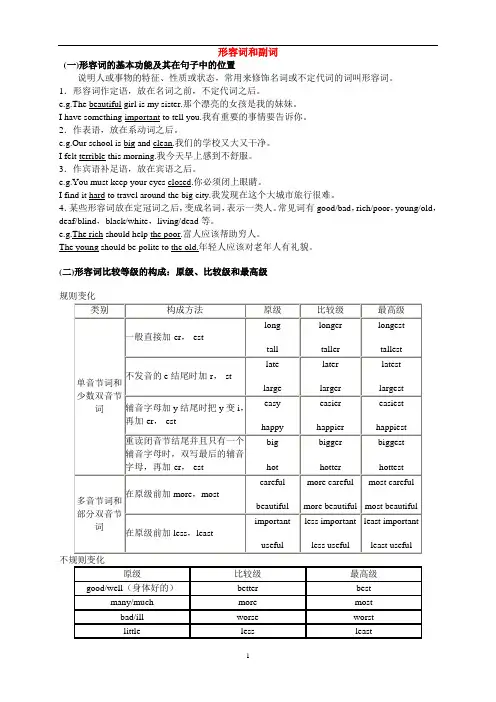
形容词和副词(一)形容词的基本功能及其在句子中的位置说明人或事物的特征、性质或状态,常用来修饰名词或不定代词的词叫形容词。
1.形容词作定语,放在名词之前,不定代词之后。
e.g.The beautiful girl is my sister.那个漂亮的女孩是我的妹妹。
I have something important to tell you.我有重要的事情要告诉你。
2.作表语,放在系动词之后。
e.g.Our school is big and clean.我们的学校又大又干净。
I felt terrible this morning.我今天早上感到不舒服。
3.作宾语补足语,放在宾语之后。
e.g.You must keep your eyes closed.你必须闭上眼睛。
I find it hard to travel around the big city.我发现在这个大城市旅行很难。
4.某些形容词放在定冠词之后,变成名词,表示一类人。
常见词有good/bad,rich/poor,young/old,deaf/blind,black/white,living/dead等。
e.g.The rich should help the poor.富人应该帮助穷人。
The young should be polite to the old.年轻人应该对老年人有礼貌。
(二)形容词比较等级的构成:原级、比较级和最高级规则变化不规则变化(三)形容词原级用法1.说明人或事物自身的特征、性质和状态时用形容词原级。
The boy is too young.Math is very difficult.数学很难。
3.表示A与B在某一方面程度相同或不同时用形容词原级。
(1)肯定句中的结构:“A…+as+形容词原级+as+B”e.g.English is as interesting as Chinese.英语和语文一样有趣。
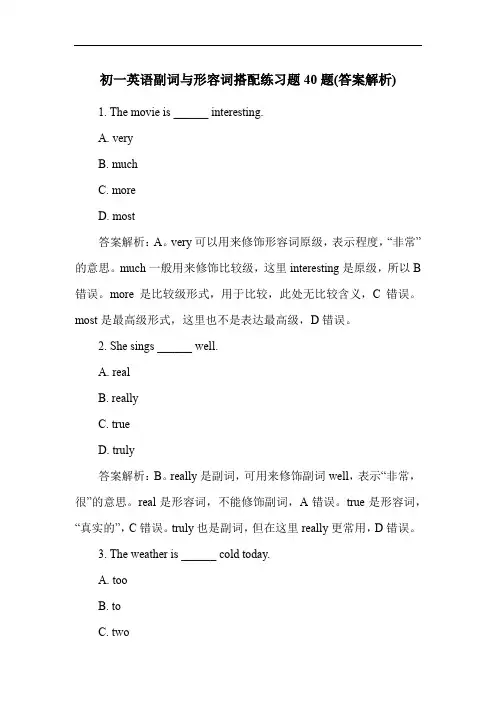
初一英语副词与形容词搭配练习题40题(答案解析)1. The movie is ______ interesting.A. veryB. muchC. moreD. most答案解析:A。
very可以用来修饰形容词原级,表示程度,“非常”的意思。
much一般用来修饰比较级,这里interesting是原级,所以B 错误。
more是比较级形式,用于比较,此处无比较含义,C错误。
most是最高级形式,这里也不是表达最高级,D错误。
2. She sings ______ well.A. realB. reallyC. trueD. truly答案解析:B。
really是副词,可用来修饰副词well,表示“非常,很”的意思。
real是形容词,不能修饰副词,A错误。
true是形容词,“真实的”,C错误。
truly也是副词,但在这里really更常用,D错误。
3. The weather is ______ cold today.A. tooB. toC. two答案解析:A。
too是副词,可用来修饰形容词cold,表示“太”的意思。
to是介词或不定式符号,B错误。
two是数词,“二”,C错误。
do是动词,D错误。
4. He runs ______ fast.A. soB. suchC. howD. what答案解析:A。
so是副词,可以修饰形容词fast,表示“如此”的意思。
such是形容词,不能修饰副词,B错误。
how是疑问副词,这里不是疑问句,C错误。
what是疑问代词,D错误。
5. The boy is ______ lazy.A. a bitB. a little ofC. a lotD. a few答案解析:A。
a bit可以用来修饰形容词lazy,表示“有点儿”的意思。
a little可直接修饰形容词,不需要of,B错误。
a lot一般用来修饰动词,C错误。
a few修饰可数名词复数,不能修饰形容词,D错误。
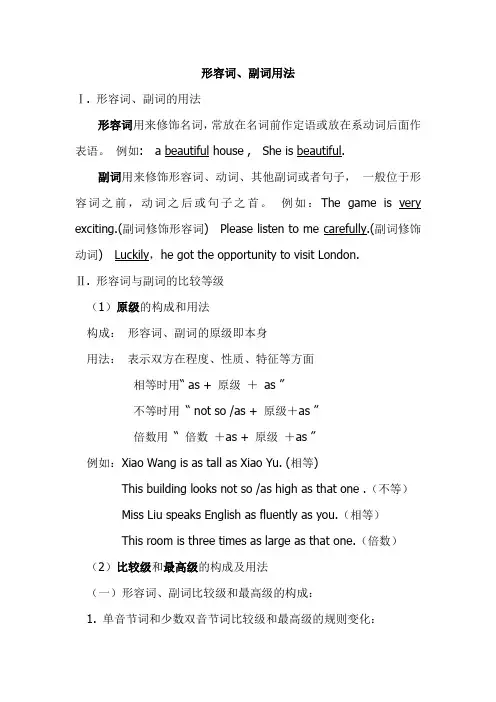
形容词、副词用法Ⅰ. 形容词、副词的用法形容词用来修饰名词,常放在名词前作定语或放在系动词后面作表语。
例如: a beautiful house , She is beautiful.副词用来修饰形容词、动词、其他副词或者句子,一般位于形容词之前,动词之后或句子之首。
例如:The game is very exciting.(副词修饰形容词) Please listen to me carefully.(副词修饰动词) Luckily,he got the opportunity to visit London.Ⅱ. 形容词与副词的比较等级(1)原级的构成和用法构成:形容词、副词的原级即本身用法:表示双方在程度、性质、特征等方面相等时用“ as + 原级+as ”不等时用“ not so /as + 原级+as ”倍数用“ 倍数+as + 原级+as ”例如:Xiao Wang is as tall as Xiao Yu. (相等)This building looks not so /as high as that one .(不等)Miss Liu speaks English as fluently as you.(相等)This room is three times as large as that one.(倍数)(2)比较级和最高级的构成及用法(一)形容词、副词比较级和最高级的构成:1. 单音节词和少数双音节词比较级和最高级的规则变化:2. 其他双音节词或多音节词,在该词前面加-more/most Beautiful — more beautiful — (the) most beautiful3. 由形容词加ly构成的双音节词和多音节词,都是在该词前加-more/most.Quickly — more quickly — (the) most quicklyDifficultly — more difficultly — (the) most difficultly4. 不规则变化:(二)比较级的用法1)两者间比较,表示一方超过另一方时,用“比较级+than “ 的结构This picture is more beautiful than that one .2)表示一方不及另一方时,用“ less + 原级+than”结构This room is less beautiful than that one.3) 表示一方在程度或数量上超过另一方时,可在比较级前加表示程度的状语,如even , a lot , a bit , a little, still, much , far , yet ,by far等修饰。
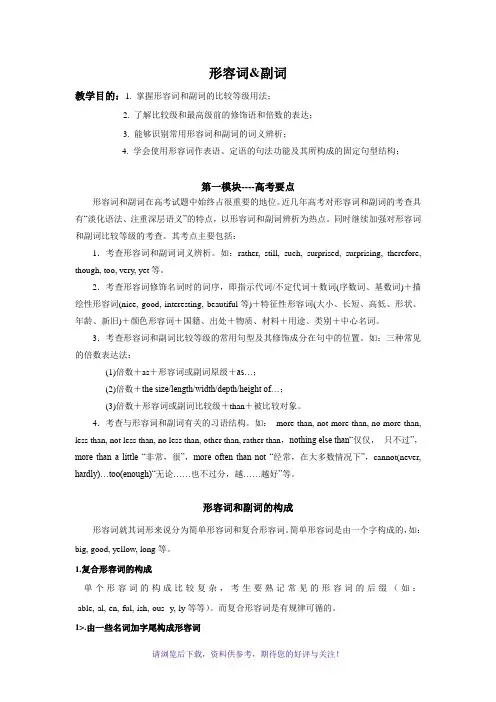
形容词&副词教学目的:1. 掌握形容词和副词的比较等级用法;2. 了解比较级和最高级前的修饰语和倍数的表达;3. 能够识别常用形容词和副词的词义辨析;4. 学会使用形容词作表语、定语的句法功能及其所构成的固定句型结构;第一模块----高考要点形容词和副词在高考试题中始终占很重要的地位。
近几年高考对形容词和副词的考查具有“淡化语法、注重深层语义”的特点,以形容词和副词辨析为热点。
同时继续加强对形容词和副词比较等级的考查。
其考点主要包括:1.考查形容词和副词词义辨析。
如:rather, still, such, surprised, surprising, therefore, though, too, very, yet等。
2.考查形容词修饰名词时的词序,即指示代词/不定代词+数词(序数词、基数词)+描绘性形容词(nice, good, interesting, beautiful等)+特征性形容词(大小、长短、高低、形状、年龄、新旧)+颜色形容词+国籍、出处+物质、材料+用途、类别+中心名词。
3.考查形容词和副词比较等级的常用句型及其修饰成分在句中的位置。
如:三种常见的倍数表达法:(1)倍数+as+形容词或副词原级+as…;(2)倍数+the size/length/width/depth/height of…;(3)倍数+形容词或副词比较级+than+被比较对象。
4.考查与形容词和副词有关的习语结构。
如:more than, not more than, no more than, less than, not less than, no less than, other than, rather than,nothing else than“仅仅,只不过”,more than a little “非常,很”,more often than not “经常,在大多数情况下”,cannot(never, hardly)…too(enough)“无论……也不过分,越……越好”等。
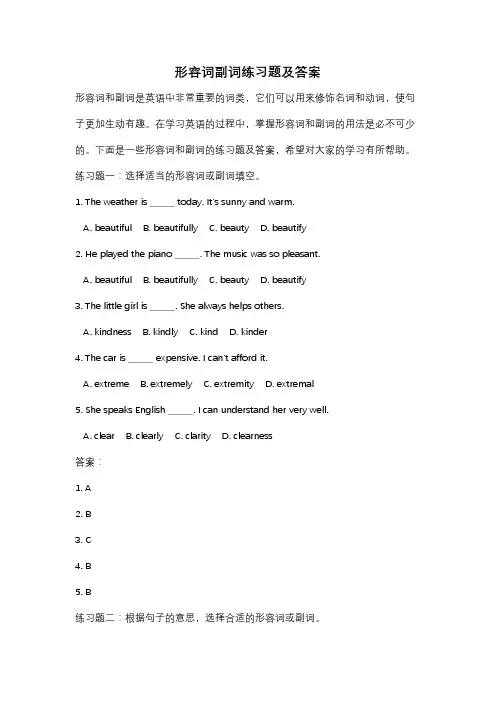
形容词副词练习题及答案形容词和副词是英语中非常重要的词类,它们可以用来修饰名词和动词,使句子更加生动有趣。
在学习英语的过程中,掌握形容词和副词的用法是必不可少的。
下面是一些形容词和副词的练习题及答案,希望对大家的学习有所帮助。
练习题一:选择适当的形容词或副词填空。
1. The weather is ______ today. It's sunny and warm.A. beautifulB. beautifullyC. beautyD. beautify2. He played the piano ______. The music was so pleasant.A. beautifulB. beautifullyC. beautyD. beautify3. The little girl is ______. She always helps others.A. kindnessB. kindlyC. kindD. kinder4. The car is ______ expensive. I can't afford it.A. extremeB. extremelyC. extremityD. extremal5. She speaks English ______. I can understand her very well.A. clearB. clearlyC. clarityD. clearness答案:1. A2. B3. C4. B5. B练习题二:根据句子的意思,选择合适的形容词或副词。
1. The food in this restaurant is ______. I highly recommend it.A. deliciouslyB. deliciousC. deliciousnessD. deliciousment2. He ran ______ to catch the bus, but he still missed it.A. fastlyB. fastC. fastnessD. fasten3. The movie was ______. I fell asleep halfway through.A. boringlyB. boringC. boringnessD. bore4. She sings ______. Her voice is so sweet.A. beautifulB. beautifullyC. beautyD. beautify5. The teacher explained the lesson ______. We all understood it.A. clearB. clearlyC. clarityD. clearness答案:1. B2. B3. B4. A5. B练习题三:根据句子的意思,填入合适的形容词或副词。
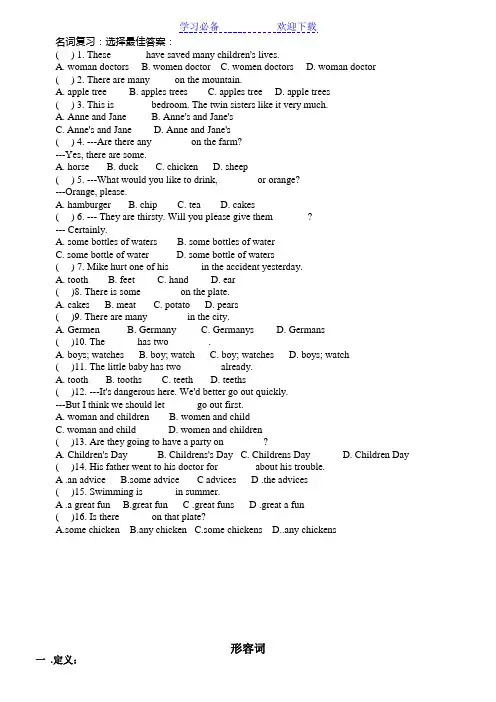
名词复习:选择最佳答案:( ) 1. These ______ have saved many children's lives.A. woman doctorsB. women doctorC. women doctorsD. woman doctor( ) 2. There are many on the mountain.A. apple treeB. apples treesC. apples treeD. apple trees( ) 3. This is _______bedroom. The twin sisters like it very much.A. Anne and JaneB. Anne's and Jane'sC. Anne's and JaneD. Anne and Jane's( ) 4. ---Are there any _______ on the farm?---Yes, there are some.A. horseB. duckC. chickenD. sheep( ) 5. ---What would you like to drink, _______ or orange?---Orange, please.A. hamburgerB. chipC. teaD. cakes( ) 6. --- They are thirsty. Will you please give them ______ ?--- Certainly.A. some bottles of watersB. some bottles of waterC. some bottle of waterD. some bottle of waters( ) 7. Mike hurt one of his ______in the accident yesterday.A. toothB. feetC. handD. ear( )8. There is some _______ on the plate.A. cakesB. meatC. potatoD. pears( )9. There are many _______ in the city.A. GermenB. GermanyC. GermanysD. Germans( )10. The______ has two _______ .A. boys; watchesB. boy; watchC. boy; watchesD. boys; watch( )11. The little baby has two _______ already.A. toothB. toothsC. teethD. teeths( )12. ---It's dangerous here. We'd better go out quickly.---But I think we should let ______go out first.A. woman and childrenB. women and childC. woman and childD. women and children( )13. Are they going to have a party on _______ ?A. Children's DayB. Childrens's DayC. Childrens DayD. Children Day( )14. His father went to his doctor for _______about his trouble.A .an advice B.some advice C advices D .the advices( )15. Swimming is ______in summer.A .a great fun B.great fun C .great funs D .great a fun( )16. Is there ______on that plate?A.some chickenB.any chickenC.some chickensD..any chickens形容词一.定义:用来修饰名词,表示人或事物的性质、状态和特征的词,叫形容词。
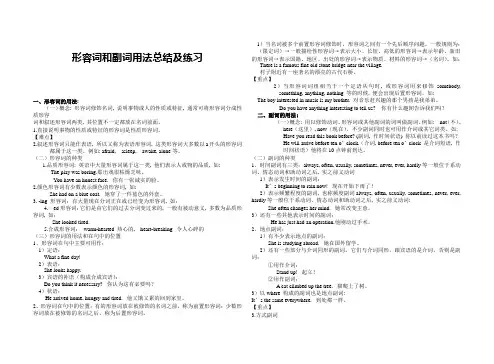
形容词和副词用法总结及练习一、形容词的用法:(一)概念: 形容词修饰名词, 说明事物或人的性质或特征, 通常可将形容词分成性质形容词和叙述形容词两类, 其位置不一定都放在名词前面。
1.直接说明事物的性质或特征的形容词是性质形容词。
【难点】2.叙述形容词只能作表语, 所以又称为表语形容词, 这类形容词大多数以a开头的形容词都属于这一类。
例如: afraid, asleep, awake, alone等。
(二)形容词的种类1.品质形容词: 英语中大量形容词属于这一类, 他们表示人或物的品质, 如:The play was boring.那出戏很枯燥乏味。
You have an honest face. 你有一张诚实的脸。
2.颜色形容词有少数表示颜色的形容词, 如:She had on a blue coat. 她穿了一件蓝色的外套。
3. -ing 形容词:有大量现在分词正在或已经变为形容词, 如:4.–ed形容词:它们是由它们的过去分词变过来的, 一般有被动意义, 多数为品质形容词, 如:She looked tired.5.合成形容词:warm-hearted 热心的, heart-breaking 令人心碎的(三)形容词的用法和在句中的位置1、形容词在句中主要可用作:1)定语:What a fine day!2)表语:She looks happy.3)宾语的补语(构成合成宾语):Do you think it necessary? 你认为这有必要吗?4)状语:He arrived home, hungry and tired. 他又饿又累的回到家里。
2、形容词在句中的位置:有的形容词放在被修饰的名词之前,称为前置形容词;少数形容词放在被修饰的名词之后,称为后置形容词。
1)当名词被多个前置形容词修饰时,形容词之间有一个先后顺序问题。
一般规则为:(限定词)→一般描绘性形容词→表示大小、长短、高低的形容词→表示年龄、新旧的形容词→表示国籍、地区、出处的形容词→表示物质、材料的形容词→(名词)。
形容词和副词I.形容词:形容词的位置:1) 形容词作定语通常前置,但在下列情况后置:2)多个形容词修饰同一个名词的顺序:3) 复合形容词的构成:II. 副词副词的分类:/III.形容词和副词的原级、比较级和最高级的用法:}注意:有些形容词,如dead, empty, round, sure, woolen 等受本身含义的限制,没有比较级。
形容词和副词比较等级:形容词和副词的比较等级分为原级,比较级和最高级。
比较级和最高级的构成一般是在形容词和副词后加-er和-est,多音节和一些双音节词前加more 和most。
1. 同级比较时常常用as…as…以及not so(a s)…as…如:I am not so good a player as you are.2. 可以修饰比较级的词有:much, many, a lot, even, far, a bit, a little, still, yet, by far, any, a great deal。
3. 表示一方随另一方变化时用“the more…the more…”句型。
如:The harder you work, the more progress you will make.4. 用比较级来表达最高级的意思。
如:I have never spent a more worrying day.5. 表示倍数的比较级有如下几种句型:Our school is three times larger than yours./Our school is four times as large as yours./Our school is four times the size of yours.6. 表示“最高程度“的形容词没有最高级和比较级。
如:favourite, excellent, extreme, perfect。
()1. It was __________ weather that they decided to go out for a picnic.A. such fineB. such a fineC. so fineD. so fine a()2. My parents will go there by taxi because it is raining____________.$A. badlyB. hardlyC. probablyD. heavily()3. Daniel is a careful driver, but he drives _______ of my friends.A. more carefullyB. the most carefullyC. less carefullyD. the least carefully()4. Mrs King kept weighing herself to see how much________she was getting.A. heavyB. heavierC. the heavierD. the heaviest()5. —Did you watch the basketball match last weekend—Yes, I did. It was covered________, and I think it was wonderful.A. liveB. alive C living D. lively?()6. The girl's voice sounds________. Maybe she can become a good singer when she grows up.A. sweetB. sweetlyC. beautifully()7. —How are you today, Bob—I'm even_______now. I don't think the medicine is good for me.A. betterB. worseC. happierD. unluckier()8. Billy has all kinds of different ideas. He is________to be a famous writer.A. enough creativeB. creative enoughC. energetic enoughD. enough energetic ()9. Helen learns to dance three times a week. Now she dances________Anita does.A. so good asB. as well asC. as good asD. so well as()10. When the fire broke out, many people were so________that they ran________. A. frightening; wild B. frightened; wild C. frightened; wildly D. frightening; wildly ()11. The work is too difficult for Mr Zhu to finish in a week. He needs________days. A. more two B. two more C. two another D. another more ()12. In the Science Museum, the children felt________to see so many________things.A. surprised; amazedB. surprising; amazing C surprising; amazed D. surprised; amazing ()13. It was ______________ music that I lost myself in it.A. such a beautifulB. so beautiful aC. so beautifulD. such beautiful()14. Be ________. Make sure not to make the same spelling mistake next time.A. peacefulB. carefulC. helpfulD. thankful()15. When an earthquake happens, and you are outdoors, you should keep calm and goto an open area as ________as possible.A. slowlyB. quietlyC. widelyD. quickly()16. I've got nothing to do. I'm ______.A. boredB. interestedC. excitedD. frightened()17. She was ______ well dressed that she attracted everyone's attention at the party.A. soB. quiteC. tooD. very()18. Peter drives________Amy, so it will take Peter time to get to the hotel. A. much faster than; less B. more slowly than; lessC as fast as; more D. as slowly as; more。
专题复习---形容词和副词(一)一、形容词的构成及其用法用以修饰名词等表示人和事物的性质、特征的词叫形容词。
它在句中可以充当定语、表语和宾语补足语,一般放在所修饰词的前面。
Eg. Those big moon cakes are delicious. (作表语)Eg. There are many beautiful flowers in the park. (作定语)1.修饰词尾为-body/-one; -thing不定代词时,必须放在其后。
Eg. There’s nothing wrong with my bike.Eg. Please give me something delicious to eat.Eg. Anybody clever can’t do such stupid things.2.表示长、宽、高、深或年龄的形容词的常用结构:数词+名词+形容词12 years old/ 8meters long/ 3 meters wide/ 100 kilometers high/ 1.8meters tallEg. It’s a river 6 meters deep.Eg. That’s a road 300 kilometers long.Eg. The young man is 1.8 meters tall.3.系动词(look, sound, smell, taste, feel)之后要接形容词Eg. The soup tastes nice.Eg. They all looked very happy after hearing the good news.4.–ing形容词和-ed形容词的区别-ed形容词通常用来形容人,而-ing形容词通常用来形容事或物如:disappointed/excited/interested/surprised/bored/amazed/relaxed(某人)感到失望/兴奋/有趣/奇怪/厌烦/震惊/放松disappointing /exciting /interesting /surprising /boring /amazing/ relaxing(某事)令人失望的/兴奋的/有趣的/奇怪的/厌烦的/震惊的/放松的5.“the +部分形容词”表示“一类人”the young the old the rich the poor二、副词的构成和用法。
形容词、副词的基本用法(一)形容词是表示事物特征和性质的词类,通常在句中作表语、宾语补足语、定语等。
1.形容词主要在下列动词后作宾语补足语:(1)表示感觉的动词,如:feel, find, see等。
►She felt the palm of his hand wet with sweat.她感觉他的手掌被汗水湿透了。
(2)表示致使的动词,如:get, have, leave, make, set, turn等。
►He got his shoes and socks wet.他把鞋袜都弄湿了。
2.形容词有时也可作状语表示伴随或结果,通常用来说明主语的情况,表示主语的状态、性质、特征等,并不表示动作的方式。
►They started the experiment, hopeful for success.他们开始作实验,相信一定会成功。
(二)副词表示动作、状态、特征等的性质(方式、程度、数量等),或指出动作和状态的发生或存在的状况,因此副词的语法意义是多样的,副词在句中主要作状语,也可作表语、定语、宾语补足语。
1.作状语是副词的主要句法功能,作状语时它修饰动词、形容词和其他副词。
►He looked tired, so deathly tired.他看起来累了,累得要死。
2.有些副词还可以作连词,作副词时常放在句末,有时也可位于句首或句中。
►He is old. He works hard, though.=Though he is old, he works hard.虽然他年事已高,但他工作还是很努力。
常见连接副词的用法:3.等。
►Fortunately, he was not drowned and was saved by the PLA.幸运的是,他没被淹死,被解放军救了。
形容词、副词表示倍数的句型1.A is (v.)+倍数+比较级+than+B2.A is (v.)+倍数+as+原级+as+B3.A is (v.)+倍数+the+名词(size, length, height 等)+of+B4.A is (v.)+倍数+that+of+B5.A is (v.)+倍数+as many/much+名词+as+B6.A is (v.)+倍数+what 引导的名词性从句►This building is two times higher than that one.=This building is three times as high as that one.=This building is three times the height of that one.这个建筑物是那个建筑物的3倍高。
高考语法复习:形容词、副词讲解及提升练习考点一:形容词和副词的用法1.形容词的基本用法(1)形容词在句中可作定语、表语、宾语补足语、主语补足语、状语等。
Although it doesn't taste of anything special,it's still worth a try. 尽管它尝起来没有任何特殊的地方,但是还是值得一试。
Conditions were so bad that it was impossible for him to find the trail again.天气状况太差,他想找到雪橇的轨迹是不可能的。
(2)形容词作状语主要表示原因、结果或伴随等,其逻辑主语必须与句子主语保持一致。
Light hearted and optimistic,she is the sort of woman to spread sunshine to people through her smile.她无忧无虑、积极乐观,是那种用微笑给别人带来快乐的人。
[易错提醒]以ly结尾的形容词,常见的有:friendly,lovely,lively,lonely,elderly,deadly 等。
2.副词的基本用法(1)副词主要用来修饰动词、形容词、其他副词或修饰整个句子,表示时间、地点、程度、方式等。
They gave money to the old people's home either personally or through their companies.他们或者亲自或者通过他们的公司给敬老院送钱。
(2)常考的连接性副词:though“然而,可是”(用于句末);meanwhile“在此期间”;therefore/thus/consequently“因此,所以”;moreover/furthermore“而且,此外”;besides“另外,还有”;however“然而”;instead“相反,代替”;anyway/anyhow“尽管,即使这样”;otherwise“否则”。
名词复习:选择最佳答案:( ) 1. These ______ have saved many children's lives.A. woman doctorsB. women doctorC. women doctorsD. woman doctor( ) 2. There are many on the mountain.A. apple treeB. apples treesC. apples treeD. apple trees( ) 3. This is _______bedroom. The twin sisters like it very much.A. Anne and JaneB. Anne's and Jane'sC. Anne's and JaneD. Anne and Jane's( ) 4. ---Are there any _______ on the farm?---Yes, there are some.A. horseB. duckC. chickenD. sheep( ) 5. ---What would you like to drink, _______ or orange?---Orange, please.A. hamburgerB. chipC. teaD. cakes( ) 6. --- They are thirsty. Will you please give them ______ ?--- Certainly.A. some bottles of watersB. some bottles of waterC. some bottle of waterD. some bottle of waters( ) 7. Mike hurt one of his ______in the accident yesterday.A. toothB. feetC. handD. ear( )8. There is some _______ on the plate.A. cakesB. meatC. potatoD. pears( )9. There are many _______ in the city.A. GermenB. GermanyC. GermanysD. Germans( )10. The______ has two _______ .A. boys; watchesB. boy; watchC. boy; watchesD. boys; watch( )11. The little baby has two _______ already.A. toothB. toothsC. teethD. teeths( )12. ---It's dangerous here. We'd better go out quickly.---But I think we should let ______go out first.A. woman and childrenB. women and childC. woman and childD. women and children( )13. Are they going to have a party on _______ ?A. Children's DayB. Childrens's DayC. Childrens DayD. Children Day ( )14. His father went to his doctor for _______about his trouble.A .an advice B.some advice C advices D .the advices( )15. Swimming is ______in summer.A .a great fun B.great fun C .great funs D .great a fun( )16. Is there ______on that plate?A.some chickenB.any chickenC.some chickensD..any chickens形容词一.定义:用来修饰名词,表示人或事物的性质、状态和特征的词,叫形容词。
二.有些形容词只能作表语,如:alone, afraid, asleep 等。
例如:Don't wake the sleeping baby up. He is asleep.The old man is alone.形容词用来修饰something, anything, nothing, everything等不定代词,要放在这些词的后面。
例如:You'd better tell us something interesting.The police found nothing strange in the room.多个形容词做定语时排列的先后顺序是:1)冠词或人称代词2)数词3)性质4)大小5)形状6)表示老少,新旧7)颜色8)事务、质地、人的国籍、用途。
例如:His grandpa still lives in this small short house.他爷爷还住在这个矮小的房子里。
The woman bought two beautiful Chinese plates.那个妇女买了两个漂亮的中国盘子。
形容词名词化:有些形容词前加定冠词后变成名词,表示一类人,谓语常用复数。
这类词有:rich / poor; good / bad ; young / old ; healthy / ill ; living / dead ; black / white (表示人种等)。
例如:The young should take good care of the old.年轻人应该好好照顾老人。
形容词短语做定语时要后置。
如:They are the students easy to teach.他们是很容易较的学生。
We live in a house much larger than yours.我们住的房子比你们的大得多。
else要放在疑问代词或复合不定词之后。
如:Did you see anybody else?你看到别的人了吗?三.以-ly结尾的形容词1)大部分形容词加-ly可构成副词。
但friendly,deadly,lovely,lonely,likely,lively,ugly,brotherly,仍为形容词。
Her singing was lovely.He spoke to me in a very friendly way.2)有些以-ly 结尾既为形容词,也为副词,如daily,weekly,monthly,yearly,early等。
The Times is a weekly paper. 《时代周刊》为周刊。
The Times is published weekly. 《时代周刊》每周发行一期。
副词一.定义:副词主要用来修饰动词,形容词,副词或其他结构。
二. 副词的位置:1)在实义动词之前。
2)在be动词、助动词之后。
3)多个助动词时,副词一般放在第一个助动词后。
注意:a. 大多数方式副词位于句尾,但宾语过长,副词可以提前,以使句子平衡。
例如:We could see very clearly a strange light ahead of us.我们清楚地看到前面有奇怪的光。
b. 方式副词well,badly,hard等只放在句尾。
例如:He speaks English well. 他英语说得好。
三. 副词的排列顺序:1)时间,地点副词,小单位的在前,大单位在后。
2)方式副词,短的在前,长的在后,并用and或but等连词连接。
例如:Please write slowly and carefully. 请写得慢一些,仔细一些3)多个不同副词排列:程度+地点+方式+时间副词。
注意:副词very 可以修饰形容词,但不能修饰动词。
改错:(错)I very like English.(对)I like English very much.注意:副词enough要放在形容词的后面,形容词enough放在名词前后都可。
例如:I don\'t know him well enough. 他我不熟悉。
There is enough food for everyone to eat.有足够的食物供每个人吃。
四. 兼有两种形式的副词1)close与closelyclose意思是\"近\";closely 意思是\"仔细地\"。
例如:He is sitting close to me. 他就坐在我边上。
Watch him closely. 盯着他。
2)late 与latelylate意思是\"晚\";lately 意思是\"最近\"。
例如:You have come too late. 你来得太晚了。
What have you been doing lately? 近来好吗?3)deep与deeplydeep意思是\"深\",表示空间深度;deeply时常表示感情上的深度,\"深深地\"。
例如:He pushed the stick deep into the mud.他把棍子深深插进泥里。
Even father was deeply moved by the film.老爸也被电影深深打动了。
4)high与highlyhigh表示空间高度;highly表示程度,相当于much。
例如:The plane was flying high. 这架飞机飞得很高。
I think highly of your opinion. 你的看法很有道理。
5)wide与widelywide表示空间宽度;widely意思是\"广泛地\",\"在许多地方\"。
例如:He opened the door wide. 他把门开得大大的。
English is widely used in the world.英语在世界范围内广泛使用。
6)free与freelyfree的意思是\"免费\";freely 的意思是\"无限制地\"。
例如:You can eat free in my restaurant whenever you like.无论什么时候,我这饭铺免费对你开放。